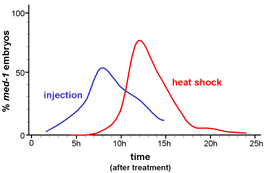Worm Breeder's Gazette 16(2): 23
These abstracts should not be cited in bibliographies. Material contained herein should be treated as personal communication and should be cited as such only with the consent of the author.
Neuroscience Res. Inst. and Dept. MCD Biology, UC Santa Barbara, Santa Barbara, CA 93106
We are using RNAi to study a
redundant pair of genes, med-1 X and med-2 III, involved in mesendoderm
(MS + E) specification. Unlike many of
the target genes used as standards for RNAi methods, the early zygotic med genes
show only moderate interference, even by direct injection of concentrated
dsRNA: at an optimized time between 7 and 9 hours after injection, ~50% of the
F1 embryos display the mutant phenotype (see Figure 1).
We have been exploring alternative
methods to generate large numbers of interfered embryos at higher penetrance. The Driscoll lab described a method for RNAi
using hsp16-2 promoter-driven expression of transgenic inverted repeat
(IR) or 'snapback' constructs (http://elegans.swmed.edu/wli/[wm99p11]/). Several attempts to construct hs-IR plasmids
for med-1 failed to yield recombinants, even using the E. coli
SURE strain, in which IRs are stabilized. We therefore sought to test the effect of expressing both sense and
antisense RNAs from an array. The MED-1
ORF was cloned into both hsp16-2 and hsp16-41 promoter vectors in
both sense and antisense orientations. Transgenic
worms carrying these four constructs on a single array were made using unc-119(+)as the selectable marker, which simplifies construction of doubles with rol-6(d)-basedGFP reporter arrays.
Heat-shock was performed on young transgenic
adults for 3 hours at 33oC, and a time course was performed at
2-hour intervals to find the optimal window for generating Med embryos. We found that the interval between 11 and 13
hours after heat-shock yielded >70% embryos with a Med phenotype. We have since obtained similar results with
an array bearing hs-sense + antisense plasmids for the redundant genes end-1
and end-3. In this case, one of
the cDNAs carried a frame-shift mutation. It is likely that introduction of such coding errors might be useful in
mitigating possible effects of overexpressing the sense message.

Figure 1. Recovery of Med embryos by two methods.
Our results suggest that expression of sense + antisense constructs from an array works at least as well as direct injection of dsRNA, and as no special cloning approaches are needed, might be an easy alternative to the hs-IR approach.